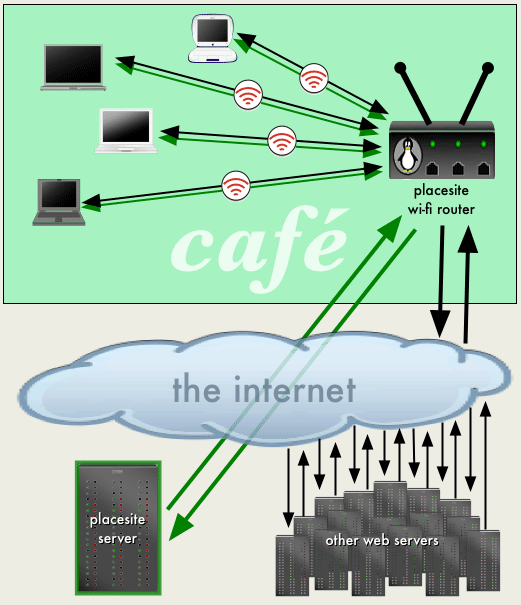Our policy of building from what already exists and designing "seeds before trees" reduces expense and hassles for café patrons, staff and owners.
Customers in a PlaceSite-enhanced wi-fi café don't have to install any special software or hardware to use the system. They can keep doing all the things they already do in standard wi-fi cafés -- although they do have to click a link at the top of the PlaceSite front page to do so. The café management doesn't have to purchase, set up or maintain a server -- all that's needed in the cafe is an off-the-shelf wi-fi router that's available for less than US$60.
In the diagram below:
black arrows = standard data flows.
This is business as usual as far as wi-fi cafés go: laptop-toting
patrons access Web sites and other Internet services provided by servers
all over the world. These data flows and these experiences could just
as easily take place from any Internet access point in the world; nothing
here is specific to the café .
green arrows
= PlaceSite data flows. These flow between the PlaceSite
server and ONLY people on-site (i.e., within wi-fi range of the café 's
router). We use these flows to build information services by, for and
about the people in the café . The presence of people online in the café
is announced to the PlaceSite server via these flows.
[ NOTE: Future versions of PlaceSite may allow people to share place-based information beyond the café , among people in different cafés, etc. But even if that happens, users will have complete control over which pieces of personal information that they've added to PlaceSite will be visible beyond their cafés. ]

The modified wi-fi router serves up café -specific content to every laptop (and every other wi-fi enabled device) within range of the router. When a person fires up her laptop in the café and opens a browser, the router gets the café 's current PlaceSite front page from the PlaceSite server and transmits that page to the person's browser.
The router also tells the server that this new person has connected. In turn the server updates the front page to tell people in the café that the new person is using the system. During all PlaceSite sessions, the router authenticates based on place -- that is, it tells the PlaceSite server that the people in the café are, in fact, in the café .
We provide the café our own modified router, so the café management can just unplug their existing router and plug in ours. If anything goes wrong, the barrista can just unplug the PlaceSite router and plug back in the café 's standard router to instantly bring back standard wi-fi Internet access.
Router specifications:
hardware: Linksys
WRT54G
Wireless-G Broadband Router, works with 802.11b and 802.11g wi-fi clients.
Cost: less than US$60, as of February 2005. [See
current prices via Froogle]
software: our
customized router software "lives" on the router. Combined with a Linux distribution, it replaces the device's factory-installed
software. The software is based on -- and built from -- the open-source WifiDog captive portal software. (Captive portal software
is often used to control access to a wi-fi access point -- for instance,
to require people to enter a username and password, or to purchase access
time, before they can get an Internet connection.) Thanks to the folks at Wifi Dog
for their great work which provided us a strong foundation to build upon.
Server software: the PlaceSite server software is written in JSP and uses a MySQL database. It creates and maintains the database of users and the information they post to the system, including forum messages, photos, and personal profile information. It also handles username/password authentication (not to be confused with place authentication, which the wi-fi router software handles).
Special thanks to C.A. Burrell of the University of Washington, who helped in coding the first version of the server software. That work was done to spec for Sean's wi-fi café research project undertaken at Intel Research Seattle during the summer of 2004, under the direction of Joe McCarthy. Like the Wifi Dog developers, C.A. and Joe provided us a strong foundation to build upon.